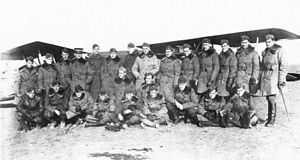139th Aero Squadron
| 139th Aero Squadron | |
|---|---|

139th Aero Squadron, Souilly Aerodrome, France, November 1918
|
|
| Active | 21 September 1917-17 June 1919 |
| Country |
|
| Branch |
|
| Type | Squadron |
| Role | Pursuit |
| Part of | American Expeditionary Forces (AEF) |
| Fuselage Code | "Flying Mercury" |
| Engagements |
World War I |
| Commanders | |
| Notable commanders |
Lt. David Endicott Putnam (Acting) Maj. Lawrence C. Angstrom |
| Insignia | |
| 139th Aero Squadron Emblem |  |
| Aircraft flown | |
| Fighter |
Nieuport 28, 1918 SPAD VII, 1918 SPAD XIII, 1918-1919 |
| Trainer | Curtiss JN-4, 1917 |
| Service record | |
|---|---|
| Operations |
2d Pursuit Group Western Front, France: 12 June-11 November 1918 |
| Victories |
34 aircraft Air Aces: 7
|
34 aircraft
Air Aces: 7
The 139th Aero Squadron was an Air Service, United States Army unit that fought on the Western Front during World War I.
The squadron was assigned as a day pursuit (fighter) squadron as part of the 2d Pursuit Group, First United States Army. Its mission was to engage and clear enemy aircraft from the skies and provide escort to reconnaissance and bombardment squadrons over enemy territory. It also attacked enemy observation balloons, and performed close air support and tactical bombing attacks on enemy forces along the front lines.
The squadron was very successful in combat, having half a dozen air aces including David Putnam, Karl Schoen, Robert Opie Lindsay, and future Brigadier General Harold H. George.
After the 1918 Armistice with Germany, the squadron returned to the United States in June 1919 and was demobilized. There is no current United States Air Force or Air National Guard unit that shares its lineage and history.
The 139th Aero Squadron was organized at Kelly Field, Texas on 21 September 1917. After a period of indoctrination training, orders were issued for the squadron to proceed to Toronto, Quebec, Canada for technical training under the British Royal Flying Corps (RFC). However, these orders were countermanded and the squadron remained at Kelly Field until 28 October 1917, when it was ordered to proceed to Barron Field, Everman, Texas for training under the RFC. One week later it moved again to Hicks Field, Saginaw Texas for further training. During the squadron's training at Hicks Field, numerous transfers of personnel were made and the squadron was brought to a strength of 204 men.
...
Wikipedia
